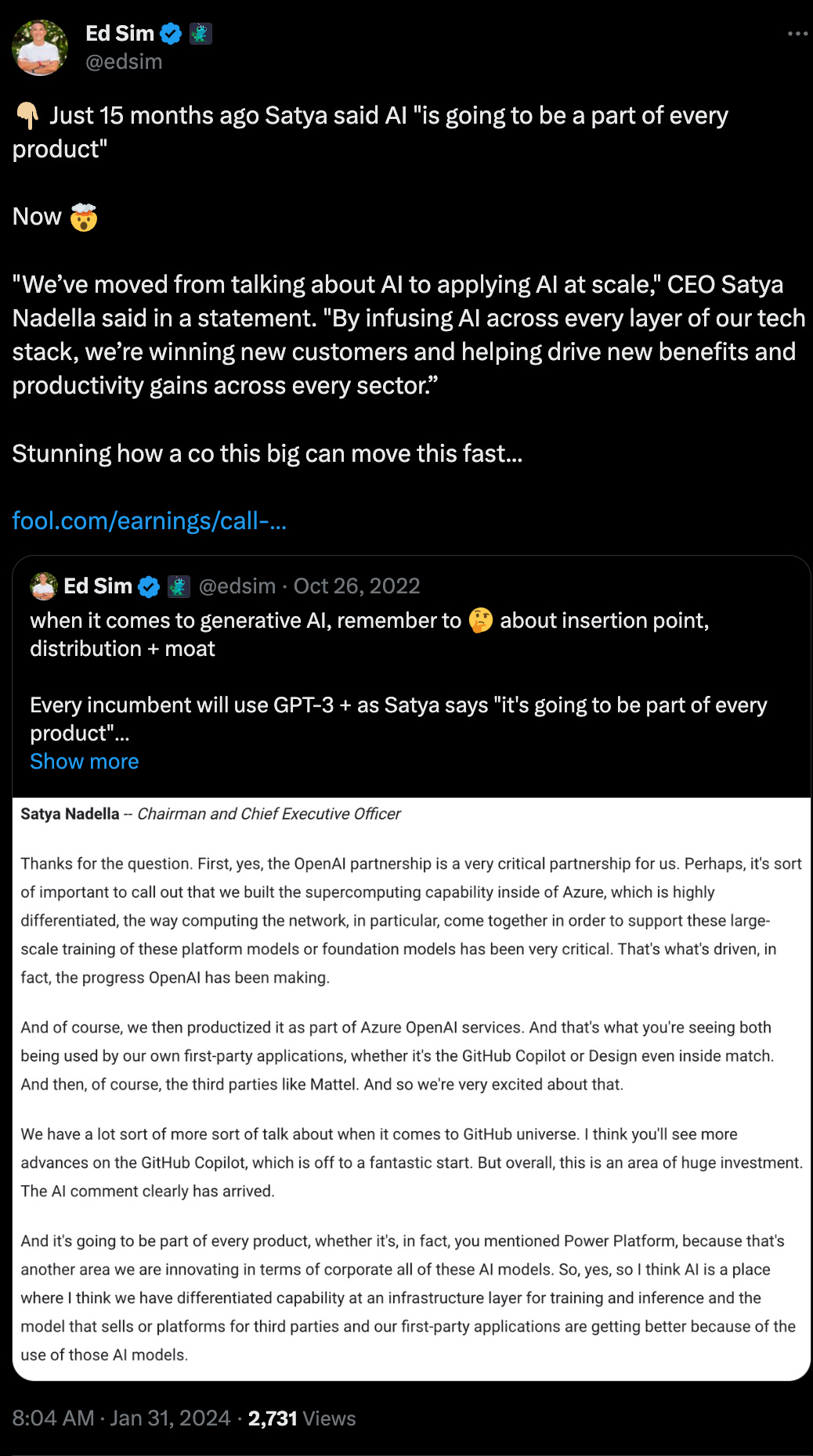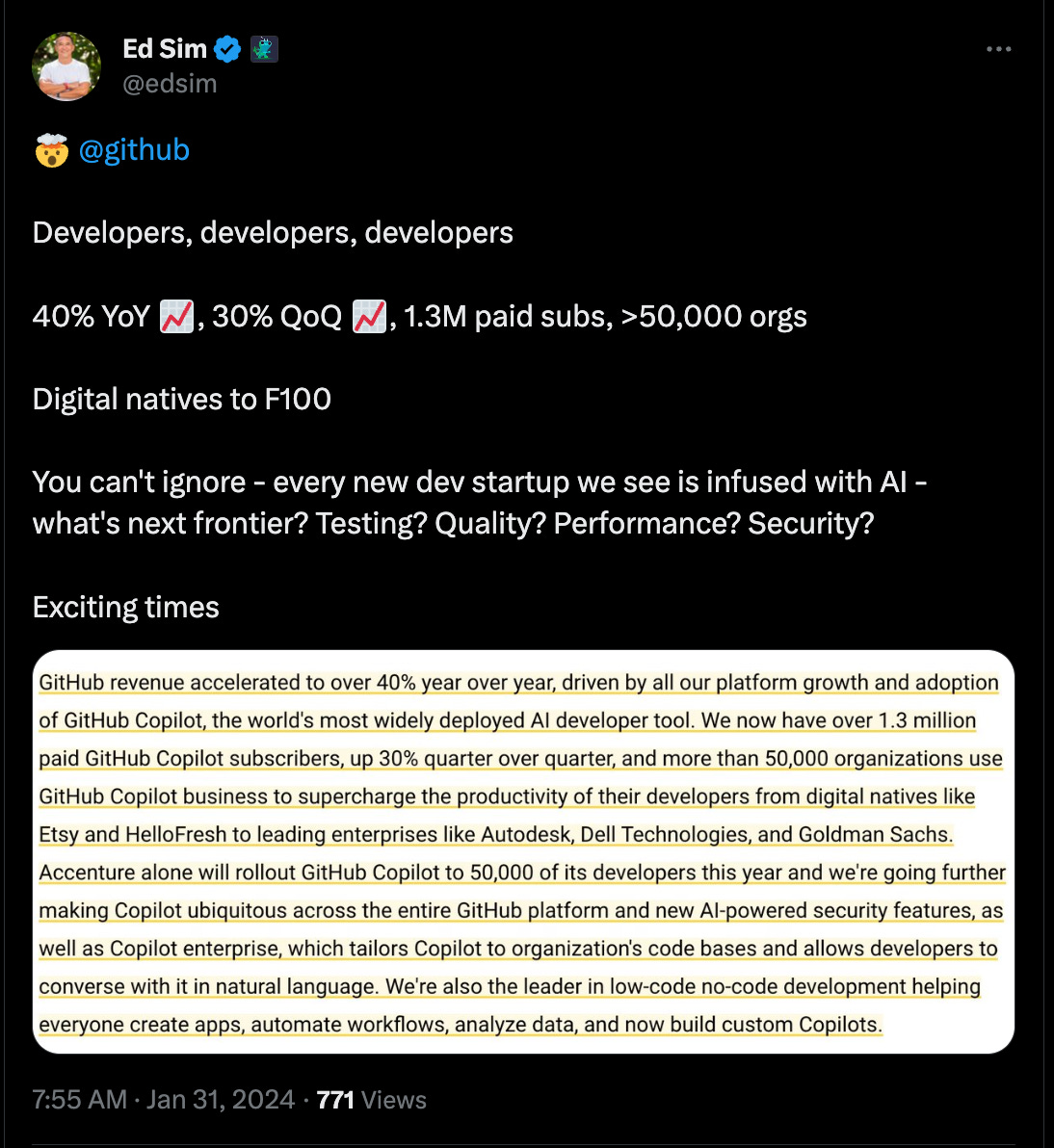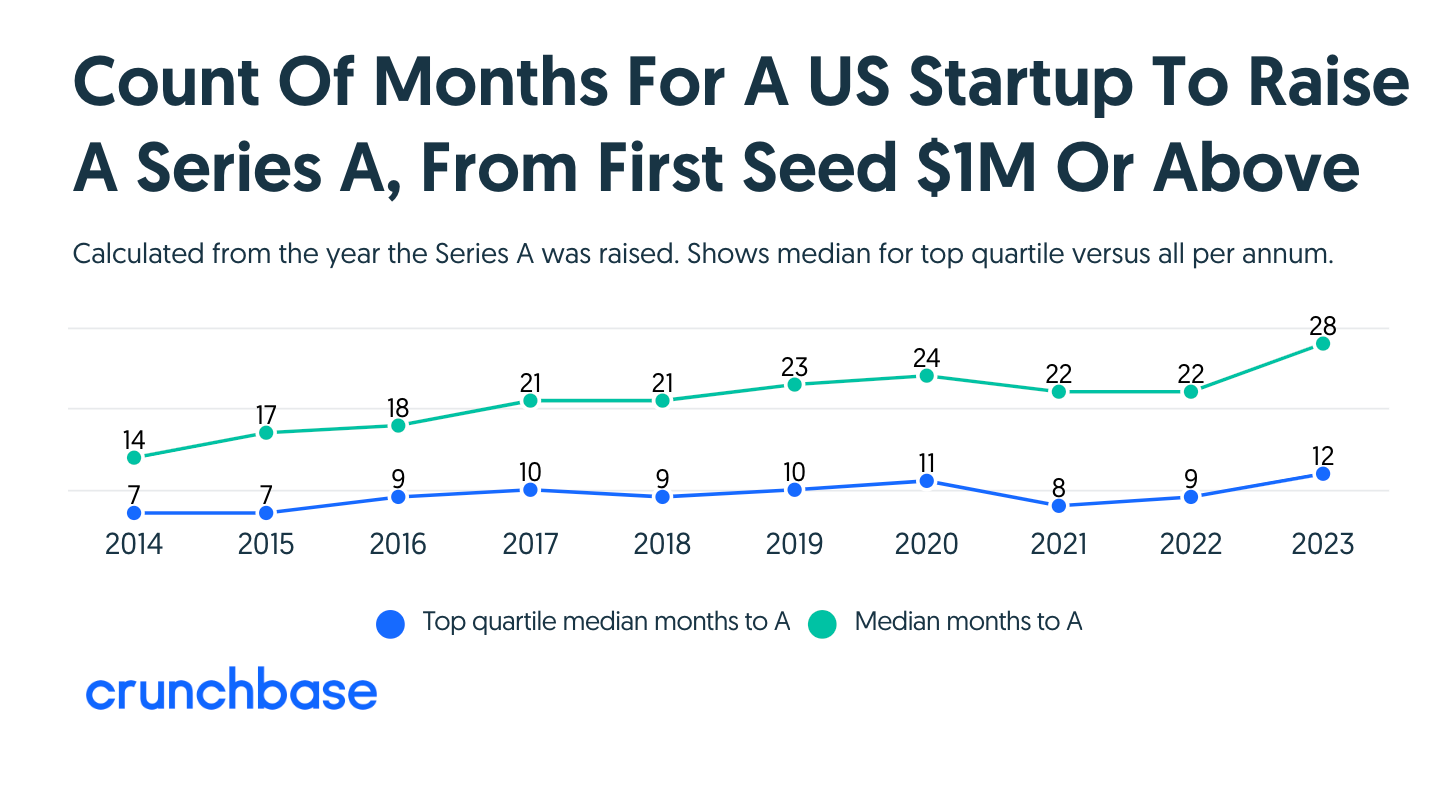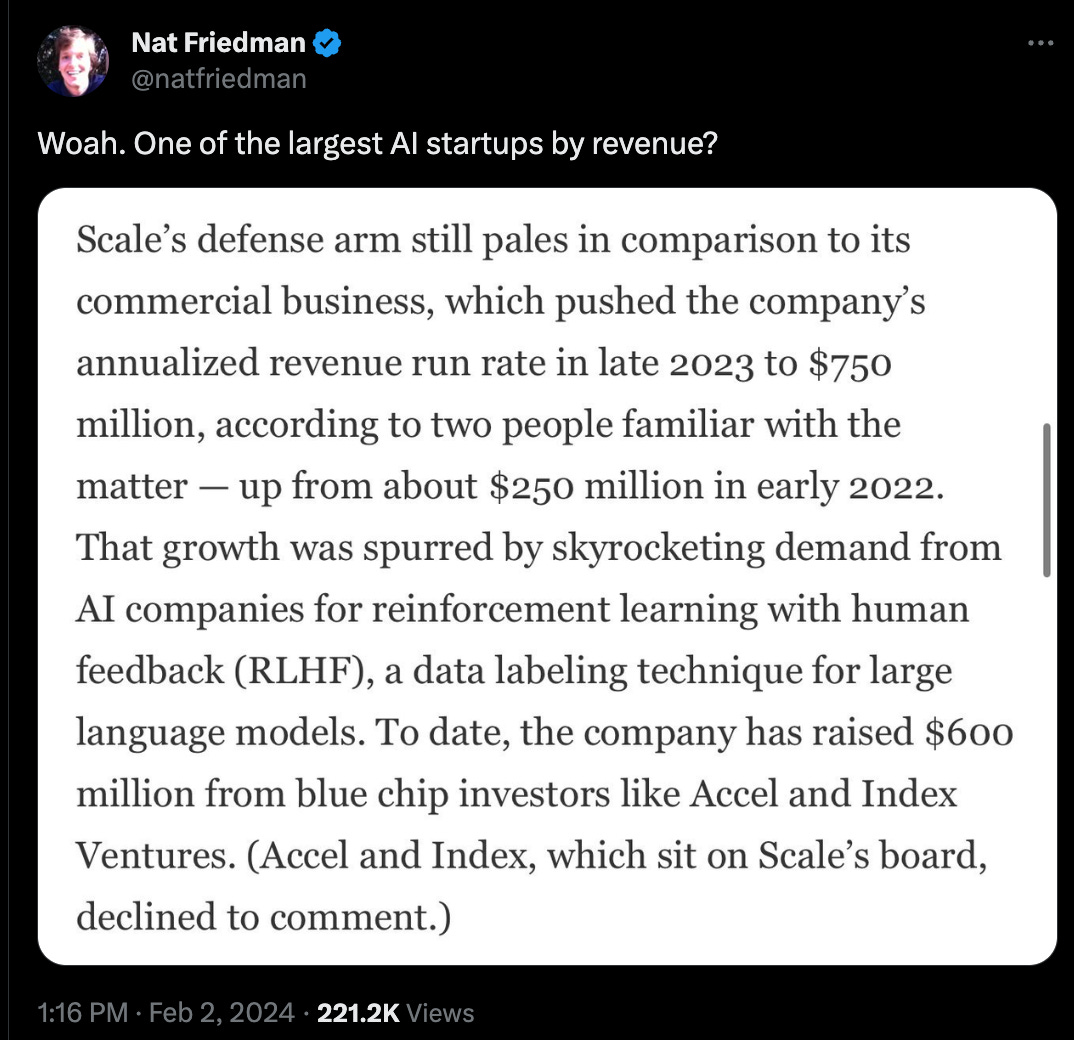| Developers, developers, developer and Microsoft, Microsoft, Microsoft. I just want to remind everyone that just 15 months ago in the October 2022 earnings call, Satya dropped his vision for the future: I continue blown away by how a company this large can embrace a new technology like AI and infuse the technology into every layer of its tech stack and deliver results.
So let’s dive into the earnings transcript since there are so many nuggets of wisdom to share and to contemplate what this means for the startup ecosystem. Broadly speaking, Microsoft’s Q2 results exceeded Wall Street expectations and Azure continued to gain market share from AWS. Within that segment, revenue from Azure and other cloud services grew 30%. Analysts polled by CNBC had expected 27.7% growth, and the StreetAccount consensus was 27.5%. The metric for the previous quarter was 29%. Six points of the Azure and other cloud services growth were tied to artificial intelligence, Amy Hood, Microsoft’s finance chief, said on a conference call with analysts.
First, what does this mean for devtools and startups? The Information published a prescient story earlier in the week about Github Copilot, “Microsoft’s AI Coding Product Becomes Weapon in Battle with AWS” (The Information). The article highlighted how the sexy wedge of AI is starting to work as Goldman Sachs and others start shifting more spend to Microsoft from Gitlab. IMO, Gitlab will be in play from a M&A perspective, and I can see a world where Google just buys Gitlab when the stock price falls a bit more, perhaps after missing earnings. Goldman Sachs, for instance, has long used a mix of GitHub, GitLab and other code repositories, according to someone familiar with the business. But the investment bank has increased spending on GitHub as it buys Copilot seats for all of its more than 10,000 software developers for around $2 million annually, including discounts, this person said. The bank also has increased spending on Azure more than 20% in the second half of last year and is on pace to spend more than $10 million annually across Azure, the person said. (Amazon Web Services is Goldman’s biggest cloud provider, and its spending trends on that cloud couldn’t be learned.)… Developers at investment firm Franklin Templeton previously used a mix of code repositories including GitLab, but the company has been moving more of that spending to GitHub so they can use Copilot, said people with direct knowledge. The amount of money the investment firm is spending couldn’t be learned, but its shift to GitHub has been gradual and could take years, these people cautioned. A Franklin Templeton spokesperson declined to comment.
Let’s zoom out and think about the second order effects if we assume that 50% of all code or more will be written by AI in the next 3+ years? Here are a few IMO and where I’m meeting some founders building insane stuff: First thought - every code copilot will eventually sell security but do you want the fox guarding the henhouse meaning that do you trust the AI that may write insecure code to secure the code? In addition if every developer can easily use a copilot plugin from Github, AWS, Google, Replit, etc, will a user want to pay separately to secure each of those? In addition, one needs AI to help review all of the AI generated code as it will be impossible to keep up - hence, why I’m so excited about Snyk, a portfolio co, and it’s Deepcode AI offering. Peter McKay of Snyk recently summarized this view in a Forbes article: McKay talked about the trend across the industry to shift left—to build security into products earlier in the development cycle and throughout the software development process. He stressed the need to be more proactive. “Every developer is now using a generative AI solution. They're developing code faster and faster—it’s like developers on steroids now. So, that disparity between developers and security continues to get further out of whack. The need for you to embed security, automate security, and automate the fixes is the only way a security team can ever keep up.”
More code = more code review, need some systems to help developers process even faster with data just beyond the code More code = more sloppy code, how should developers think about optimizing code? How can a developer get more performant code? How does one improve quality?
There are so many opportunities ahead and thinking about second order effects gets me 🔥 up! Secondly, the AI wedge overall is working as it’s growing market share against AWS in overall cloud market. In addition, over 1/3, yes 1/3 of the 53,000 Azure AI customers are new to Azure in the past 12 months! Now, I'll highlight examples of our momentum and progress, starting with Azure. Azure again took share this quarter with our AI Advantage. Azure offers the top performance for AI training and inference in the most diverse selection of AI accelerators, including the latest from AMD and NVIDIA, as well as our own first-party silicon, Azure Maia. And with Azure AI, we provide access to the best selection of foundation and open-source models, including both LLMs and SLMs, all integrated deeply with infrastructure data and tools on Azure. We now have 53,000 Azure AI customers. Over one-third are new to Azure over the past 12 months. Our new models-as-a-service offering makes it easy for developers to use LLMs from our partners, like Cohere, Meta, and Mistral, on Azure without having to manage underlying infrastructure. We have also built the world's most popular SLMs, which offer performance comparable to larger models but are small enough to run on a laptop or mobile device.
Is this a sign that we are done with cloud optimization and poised for more growth ahead? Here’s Satya - it’s over! And I think if I understand your question, what's happening with the traditional optimization, and I think last quarter we said. One, we're going to continue to have these cycles where people will build new workloads, they will optimize the workloads and then they'll start new workloads. So I think that that's what we continue to see, but that period of massive, I'll call it, optimization only and no new workloads start, that I think has ended at this point. So what you're seeing is much more of that continuous cycle by customers, both whether it comes to AI or whether it comes to the traditional workloads.
On an application-level perspective, the productivity is there. A growing body of evidence makes clear the role AI will play in transforming work. Our own research, as well as external studies, show as much as 70% improvement in productivity, using generative AI for specific work tasks, and overall early Copilot for Microsoft 365 users were 29% faster in the series of tasks, like searching, writing, and summarizing. Two months in, we have seen faster adoption than either our E3 or E5 suites as enterprises, like Dentsu, Honda, Pfizer, all deploy Copilot to their employees, and we are expanding availability to organizations of all sizes. We're also seeing a Copilot ecosystem begin to emerge ISVs like Atlassian, Mural, and Trello, as well as customers like Air India, Bayer, and Siemens have all built plug-ins for specific lines of business that extend Copilot's capabilities.
How does AI get adopted in an enterprise"? According to Satya, summarize by far is the number 1 use case, then generate/help draft, then create net new like document to PowerPoint. I see the same at Superhuman, a port co, and suspect this is how every other application that adds AI to it’s offerings will evolve. No, thank you for the question, Brad. So a couple of things. In my comments I said increase in relation to our previous suites like, let's say, E3 or E5. Whatever two months in, it's definitely much faster than that. And so from that perspective, it's exciting to see, I'd say, the demand signal, the deployment signal. I was looking at by tenant, even usage, it's faster than anything else because it's easier, right? I mean, it's sort of -- it shows up in your app, if you click on it, like any ribbon thing, and it becomes a daily habit. So it in fact, it reminds me a little bit of sort of the back in the day of PC adoption, right? It's kind of -- I think it first starts off with few people having access. There are many companies that are doing standard issue, right? So just like PCs became standard issue at some point after PCs being adopted by early adopters. I think that's the cycle that at least we expect. In terms of what we're seeing, it's actually interesting, if you look at the data we have, summarization, that's what it's like, number one. Like I'm doing summarization of Teams meetings inside of Teams, during the meeting, after the meeting, Word documents summarization, I get something in email on summarizing. So summarization has become a big deal. Drafts, right, you're drafting emails, drafting documents. So anytime you want to start something, the blank page thing goes away and you start by prompting and drafting. Chat, to me, the most powerful feature is now you have the most important database in your company, which happens to be the database of your documents and communications. It is now queryable by natural language in a powerful way, right? I can go and say, what are all the things Amy said I should be watching out for next quarter, and it will come out with great detail. And so Chat, summarization, draft, and also, by the way, actions. One of the most used thing is here's the Word document, go complete, I mean, create a PowerPoint for me. So those are the stuff that is also beginning. So I feel like these all become -- but fundamentally, what happens is, if you remember the PC adoption cycle, what it did was work artifact and workflow changed, right? You can imagine what forecasting was before Excel and email and what it was after. So similarly, you'll see work and workflow change as people summarize faster, draft regulatory submissions faster, chat to get knowledge from your business. And so those are the things that we are seeing as overall patterns.
And this is the nugget that startup founders should pay attention to: I do believe, being in the cloud has been very helpful to build AI, but now, AI is just redefining what it means to have, what the cloud looks like, both at the infrastructure level and the app model.
Here’s one more thought on why this is an exciting time to start a company - from Satya talk at Davos (Barrons): Nadella, 56, isn’t eager to harp on anniversaries—“I haven’t really reflected on the 10 years,” he says. “This is my 32nd year at Microsoft, and it’s the second year of AI. My years have been punctuated by three other paradigm shifts: PC client-server, the web, and mobile and cloud. Now the fourth is AI. And so I’m trying to go back to learn how to operate in year two of the other three paradigm shifts.”
We’re just in the second inning and no one knows much but it’s clear that in this plaform shift, we will have some massive winners emerge in the next 5 years! Yes, Microsoft is crushing it and leading the AI wave into the enterprise, but what net new applications can be built, how is this new stack reimagined from infra to app layer and think ahead to what happens when AI is in every application generating more content, code, and insights than ever before 🤔! As always, 🙏🏼 for reading and please share with your friends and colleagues.
👇🏼 the A crunch is on - from 14 - 28 months…while top quartile extended a bit - can also be reflective of size of seed rounds getting much larger (crunchbase news) More startup writedowns and writeoffs to come based on historical data from David Clark Vencap 🧵 We know that the last 12 months have been a challenging time for startups. But how has this affected the loss ratios for the venture funds that backed them. A short thread /1
👇🏼 great reminder from Robert Greene, author of Power, Mastery and other books The secret to success is retaining your child-like qualities.
Pure GTM gold - always been a huge fan of Geoffrey Moore, Crossing the Chasm - the bible for product marketing and thinking about early adopters (Lenny Rachitsky podcast) If you don't have 1-2 hours to listen to a podcast episode, I'm now adding some key takeaways from my conversations inside the show notes. You'll find them below the episode description. Here's an example from my chat with @geoffreyamoore:
Some takeaways:
1. The "chasm" is the gap between success with early adopters and success with the mainstream market. Crossing the chasm requires selling to "pragmatist customers" who, unlike early adopters, will not buy on the basis of a vision. Instead, pragmatists need a "compelling reason to buy" and a high degree of trust in the technology. To be successful, you want a target segment that is big enough to matter, small enough to lead, and a good fit with your crown jewels. Create a compelling reason to buy by addressing a critical problem or pain point for customers. Then build relationships with marquee customers and use their success stories as references to attract other
customers. When crafting a GTM strategy, ensure that the entire team is aligned around one playbook (the Early Market playbook, the Bowling Alley playbook, the Tornado playbook, or the Main Street playbook). What works in one stage will likely underperform in others, and combining playbooks can actually undermine success. The only reason you need venture capital is if (a) the technology is too expensive and you cannot self-fund it or (b) your product is going to catch fire too quickly. If done correctly, crossing the chasm should be inexpensive. Strive for cash-flow-positive and aim to change the value state of your company to attract investors and avoid constant fundraising. Discounting is not effective before crossing the chasm, as it does not reduce risk. In fact, it might even increase risk if vendors compromise on important aspects, such as support or scope, leading to potential challenges when trying to navigate the unique dynamics
Smaller is beautiful - IMO still the race to be first with the 3 kinds of Inception Rounds from Discovery <$2M, Classic $3-5M, Jumbo $6-10 or > (Meghan Reynolds - Altimeter) Heard from VC LPs this week:
Commitments up from ‘23, w/ a clear LP bias for smaller funds & early stage VC (heard from large pensions to family offices). Makes me consider implications of imbalance - will it lead to small funds getting larger and/or early migrating later?
😲 Coding copilots are clearly the future and enhance developer productivity but does it also increase tech debt? (GitClear research) The study analyzed 153 million changed lines of code, comparing changes done in 2023 versus prior years, when AI was not as relevant for code generation. Some of the findings include: “Code churn,” or the percentage of lines thrown out less than two weeks after being authored, is on the rise and expected to double in 2024. The study notes that more churn means higher risk of mistakes being deployed into production. The percentage of “copy/pasted code” is increasing faster than “updated,” “deleted,” or “moved” code. “In this regard, the composition of AI-generated code is similar to a short-term developer that doesn’t thoughtfully integrate their work into the broader project,” said GitClear founder Bill Harding.
The bottom line, per Harding: AI code assistants are very good at adding code, but they can cause “AI-induced tech debt.”
What is audio-jacking? Using generative AI to distort live audio transactions (Security Intelligence) - this is next level scary and why AI security becomes hugely important… During our exploration, we discovered a method to dynamically modify the context of a live conversation utilizing LLM, speech-to-text, text-to-speech and voice cloning. Rather than using generative AI to create a fake voice for the entire conversation, which is relatively easy to detect, we discovered a way to intercept a live conversation and replace keywords based on the context. For the purposes of the experiment, the keyword we used was “bank account,” so whenever anyone mentioned their bank account, we instructed the LLM to replace their bank account number with a fake one. With this, threat actors can replace any bank account with theirs, using a cloned voice, without being noticed. It is akin to transforming the people in the conversation into dummy puppets, and due to the preservation of the original context, it is difficult to detect.
There is AI in the enterprise without AI security and excited for Protect AI, a portfolio co, as it continues building out its end-to-end platform with the latest product via an acquisition of popular OSS project (VentureBeat) The LLM Guard open-source project that Laiyer AI leads helps to govern the usage of LLM operations.
LLM Guard has input controls to help protect against prompt injection attacks, which is an increasingly dangerous risk for AI usage. The open source technology also has input control to help limit the risk of personally identifiable information (PII) leakage as well as toxic language. On the output side, LLM Guard can help protect users against various risks including malicious URLs.
Dehghanpisheh emphasized that Protect AI remains committed to keeping the core LLM Guard technology open source. The plan is to develop a commercial offering called Laiyer AI that will provide additional performance and enterprise capabilities that are not present in the core open-source project. Protect AI will also be working to integrate the LLM Guard technology into its broader platform approach to help protect AI usage from the model development and selection stage, right through to deployment.
Great summary of best practices building with AI from Ashu Garg - Foundation Capital This month, on the cusp of B2BaCEO’s 50th podcast episode, I revisit conversations with five of my most recent and prominent guests. Each occupies a unique position at the forefront of AI. I’ve distilled the ten most important learnings for founders who are navigating the world of generative models… 8 days ago · 3 likes · Ashu Garg Impressive as Vanta crosses $100M ARR mark in 5 years for automating security compliance like SOC2 🧵 Today, we’re thrilled to announce several important milestones at Vanta, including serving over 7,000 customers and earning $100mm ARR in <5 years. Vanta’s ability to help our customers streamline security programs and automate compliance has never been stronger.
Our first principle at Vanta is “put customers first,” and we aim to do that every day. Over global 7,000 trust Vanta with their security and compliance, so we get ample reps. Vanta was founded to turn trust into a revenue-driver for companies so that more security work is prioritized more often, and it’s working.
Last year, we shipped over 260 improvements for customers, from the big – an entire second, standalone product in Vendor Risk Management – to the papercut – test details are now pages, not full-screen modals, ifykyk. That’s more than one ship every weekday!
Microsoft Future of Work research report chock full of data on effectiveness of AI How enterprises are using open source LLMs: 16 examples (VentureBeat) Speaking of Open Source LLMs this 🧵 from AI at Meta is 🔥 - all the 💰 which will be invested into AI in the coming years and what it means for open source Today, Mark Zuckerberg shared the latest on our vision for building the most advanced AI products and services in our Q4 earnings call. Here are a few highlights on our progress in AI — and how our teams are positioned to deliver on this work.
We’re building world-class compute infrastructure. By the end of 2024 we’ll have ~350k NVIDIA H100s — and a total of 600k H100 equivalents worth of compute. This scale will lay a strong foundation to support training and operating future models.
We’re continuing our long-standing strategy to build and open source software infrastructure. Earlier this week we released new, more performant versions of Code Llama to the community — available under the same license as Llama 2. We believe in the power of open source to unlock innovation in the industry while also driving benefits to our work by helping us to learn and improve quickly. https://twitter.com/AIatMeta/status/1752013879532782075
Evolving the Application Security Game (Forbes): great interview with Peter McKay, CEO of Snyk (a portfolio co) on what makes a great acquisition and commentary on the arms race in terms of more code than ever being generated and needing automation and AI to secure all of that new code (Forbes) A Vision for the Future The amalgamation of Snyk and Helios isn't just about technology; it's about people and shared visions. McKay emphasized the importance of the team behind the technology. Snyk's long-term strategy involves not just acquiring new technologies but integrating teams from acquisitions and—most importantly—fostering and maintaining their entrepreneurial spirit and innovative drive. This approach has been pivotal in Snyk's growth, ensuring that each acquisition isn't just a technological addition but a cultural and visionary alignment that enhances the company’s mission…
Calling all What’s 🔥 readers - it’s over, the secret is out, time to run for the hills - enterprise is sexy and all the VCs are running this way 🤦🏼♂️ - Lerer Hippeau and VC’s Consumer to Enterprise Pivot (The Information) Venture capitalists have given up on the idea that they’ll make their career finding the next hit consumer marketplace, retail brand or media company.
Simply value destroying from EU but Lina Khan and FTC not far behind - this needs to be fixed immediately, otherwise no big M&A deals will close which is majority of venture funded exits - “Amazon terminates iRobot deal, Roomba maker to lay off 31% of staff” - btw, breakup fee of $97M on $1.7B is 5.5% which is inline with Adobe-Figma of $1B or 5% on $20B deal Amazon and iRobot mutually agreed to call off their planned acquisition, writing that there was “no path” to regulatory approval and sending iRobot shares down sharply. iRobot, which makes the Roomba, said it will lay off around 350 employees and that its founder and CEO Colin Angle would step down. The Amazon-iRobot deal was originally valued at $1.7 billion, but a number of regulatory examinations drove the purchase price down before ultimately killing the deal.
And from The Information - the FTC When Amazon called off its $1.4 billion acquisition of iRobot on Monday morning, it blamed the European Union for scuttling the deal. But Amazon was also facing an equally large threat from the Federal Trade Commission in the U.S.
FTC officials told Amazon executives during a meeting last week that agency staff planned to recommend the FTC’s commissioners file a lawsuit to block the iRobot acquisition, according to a person familiar with the matter. The two sides had a “last rites” meeting—typically the final step before the FTC files a lawsuit—on the calendar for early this week, the person said.
What's Hot in Enterprise IT/VC is free today. But if you enjoyed this post, you can tell What's Hot in Enterprise IT/VC that their writing is valuable by pledging a future subscription. You won't be charged unless they enable payments. Pledge your support | |




